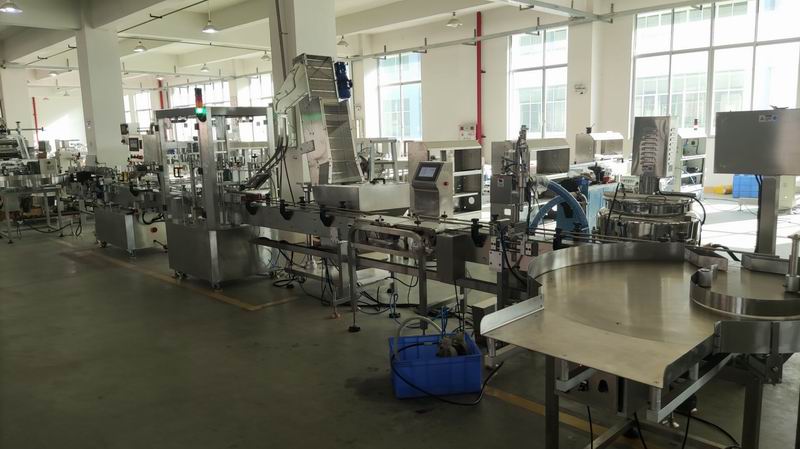The future of automatic intelligent packaging production lines will present multi-dimensional and profound changes, covering multiple levels such as technological innovation, industrial collaboration, and policy-driven. The following is an analysis of six core trends:
1. Intelligent and autonomous decision-making capabilities have leaped
1. AI deep empowerment: The accuracy of the visual inspection system has reached 60-100 microns (such as the Luzhou Laojiao production line), which can identify hair-level defects and automatically classify and trace quality defects with machine learning algorithms. The AI scheduling system can dynamically adjust the production line rhythm according to order fluctuations. After a food company applied it, the capacity utilization rate increased by 37%.
2. Digital twin technology implementation: Through virtual mapping, real-time monitoring and preview of the production line are achieved. A daily chemical company uses digital twins to optimize the changeover process and compress the changeover time from 45 minutes to 8 minutes.
3. Autonomous maintenance system: The sensor network collects equipment vibration, temperature and other data in real time, combined with predictive maintenance models, to reduce the equipment failure rate by 42% (Taizhou Huanli case).

2. Flexible production and modular reconstruction
1. Rapid changeover technology breakthrough: Modular design supports product specification switching within 15 minutes. For example, an electronics company uses a magnetic levitation conveying system to achieve rapid conversion of mobile phone and tablet packaging lines.
2. Personalized customization capabilities: The processing cost of small batch orders is reduced by 60%. A tea company uses AI visual recognition to achieve personalized blending and packaging of each box of tea.
3. Deepening of human-machine collaboration: The proportion of collaborative robots (Cobot) will reach 35%. The production line of a pharmaceutical company uses force control technology to achieve safe collaborative operation between robots and humans.
3. Green manufacturing and sustainable development
1. Accelerated substitution of environmentally friendly materials: Degradable honeycomb paper die-cutting machines reduce packaging material loss by 28%. A company uses this technology to reduce plastic use by 1,200 tons per year.
2. Improved energy efficiency: The integration of photovoltaic-energy storage systems reduces the comprehensive energy consumption of production lines by 23%. A packaging factory achieves zero carbon emissions at night through intelligent lighting and frequency conversion technology.
3. Circular economy model: The automatic sorting system for packaging waste has increased the recycling rate to 92%. A beverage company has reduced the cost of raw materials by 18% through bottle preform recycling technology.
IV. Integration of 5G and Industrial Internet
1. Popularization of 5G+MEC architecture: Hainan Huanglong Pharmaceutical's 5G workshop has achieved millisecond-level return of equipment data, and the fault response time has been shortened to 2 seconds.
2. Cloud-based collaborative manufacturing: The cross-regional production line collaboration efficiency has increased by 50%. A multinational company has achieved dynamic order allocation between Chinese and European factories through a cloud platform.
3. Digital supply chain integration: The blockchain traceability system has reduced the product traceability time from 7 days to 2 hours. A food company has accelerated the acquisition of EU organic certification through this technology.
V. Cost-effectiveness and investment return optimization
1. Labor cost reduction: The fully automatic boxing line in the e-cigarette industry has reduced the number of single-shift workers from 16 to 4, saving 3.2 million yuan in labor costs annually.
2. Reduced quality costs: The visual inspection system reduces the product defect rate from 1.8% to 0.03%, and a pharmaceutical company reduces rework losses by 4.7 million yuan per year.
3. Shortened investment payback period: Small and medium-sized enterprises shorten the investment payback period from 3 years to 18 months through leasing models (such as equipment as a service).
VI. Policy and market dual drive
1. Release of policy dividends: China's "14th Five-Year Plan" smart manufacturing plan clearly defines packaging equipment as a key area, and the market size is expected to exceed 200 billion yuan in 2025.
2. Consumption upgrade forced: E-commerce packaging demand has increased by 21% annually, and a logistics company has doubled its "same-day delivery" order processing capacity through smart packaging lines.
3. Accelerated global layout: China's equipment exports accounted for 38%, and a company customized a blister packaging line for a German customer to achieve a production capacity of 15,000 boxes/hour.
Typical case analysis:
- Luzhou Laojiao Intelligent Packaging Center: Using AI and digital twin technology, the filling speed reaches 15,000 bottles/hour, the labor is reduced by 90%, and the annual packaging capacity is 100,000 tons.
- Hubei Chuliuxiang Tea Industry: The first fully automatic production line for cup tea in China, AI robots complete the entire process of loading, packaging, and palletizing, with an annual production capacity of 100 million cups and an output value of 200 million yuan.
- Senge 5G Future Factory: 5G+ Industrial Internet achieves a 300% increase in production efficiency and a quality inspection interception rate of 99.97%.
Key technology roadmap for the next ten years:
- 2025-2027: Large-scale application of flexible robots and digital twins, and popularization of carbon footprint tracking systems.
- 2028-2030: Quantum computing optimizes scheduling algorithms, and bio-based packaging materials account for more than 30%.
- 2031-2035: Autonomous mobile robot clusters realize full-scene logistics, and the packaging system is deeply integrated with the Metaverse platform.
During this transformation process, companies need to focus on technology iteration risks (such as equipment compatibility), data security protection (industrial firewall deployment), and talent structure transformation (cultivation of compound technical talents), while seizing policy subsidy windows and industry standard setting opportunities, so as to gain the upper hand in the new round of industrial revolution.
Contact: Janine
Phone: 0086 13161354131
E-mail: janine@ga-packing.com
Add: No.2 Building, Jinxi Building Beichen District, Tianjin City China 300400